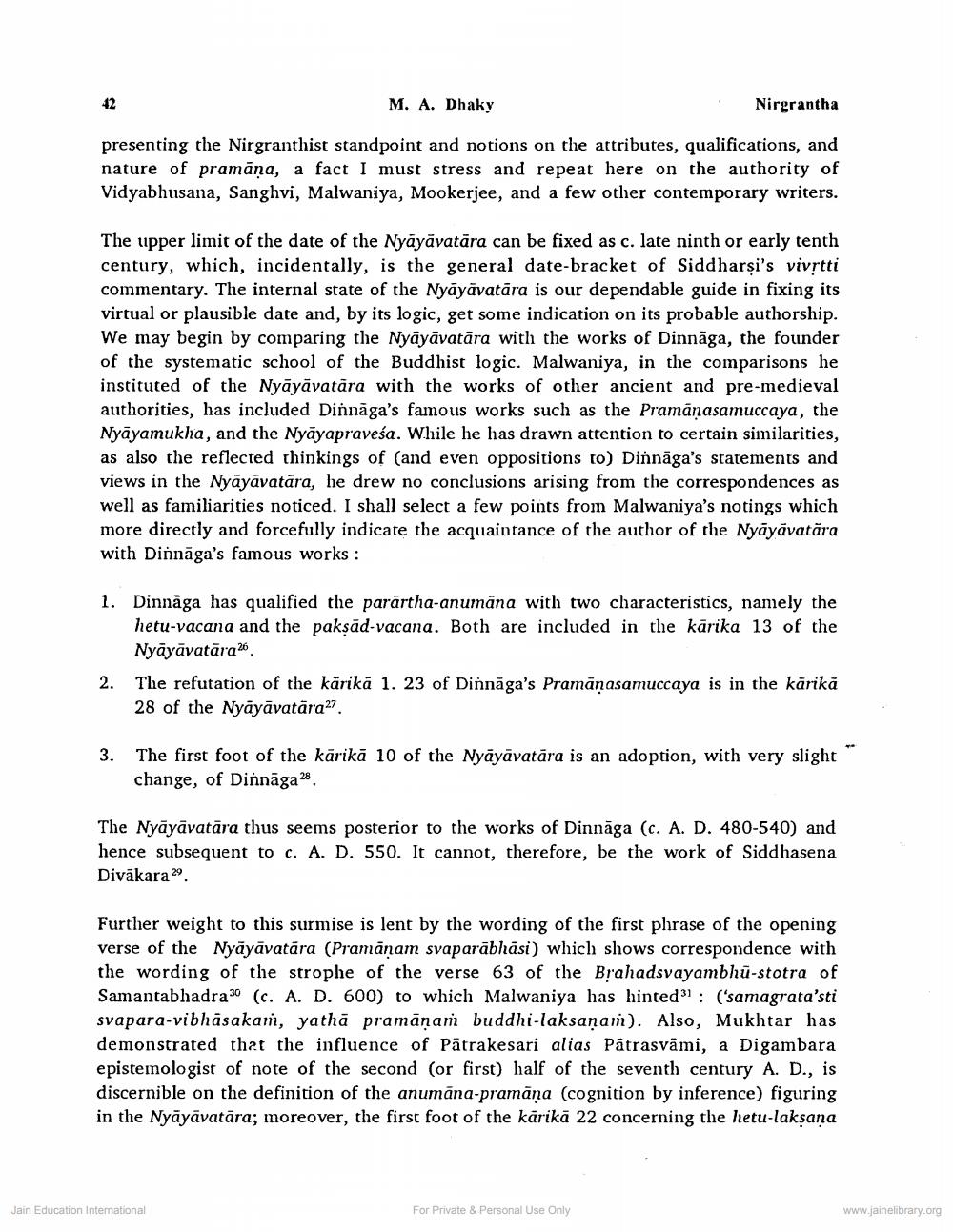________________
M. A. Dhaky
Nirgrantha
presenting the Nirgranthist standpoint and notions on the attributes, qualifications, and nature of pramāņa, a fact I must stress and repeat here on the authority of Vidyabhusana, Sanghvi, Malwaniya, Mookerjee, and a few other contemporary writers.
The upper limit of the date of the Nyāyāvatāra can be fixed as c. late ninth or early tenth century, which, incidentally, is the general date-bracket of Siddharşi's vivetti commentary. The internal state of the Nyāyāvatāra is our dependable guide in fixing its virtual or plausible date and, by its logic, get some indication on its probable authorship. We may begin by comparing the Nyāyāvatāra with the works of Dinnāga, the founder of the systematic school of the Buddhist logic. Malwaniya, in the comparisons he instituted of the Nyāyāvatāra with the works of other ancient and pre-medieval authorities, has included Dinnāga's famous works such as the Pramāṇasamuccaya, the Nyāyamukha, and the Nyāyapraveśa. While he has drawn attention to certain similarities, as also the reflected thinkings of (and even oppositions to) Dinnāga's statements and views in the Nyāyāvatāra, he drew no conclusions arising from the correspondences as well as familiarities noticed. I shall select a few points from Malwaniya's notings which more directly and forcefully indicate the acquaintance of the author of the Nyāyāvatāra with Dinnāga's famous works :
1. Dinnāga has qualified the parārtha-anumāna with two characteristics, namely the
hetu-vacana and the paksād-vacana. Both are included in the kārika 13 of the
Nyāyāvatāra26 2. The refutation of the kārikā 1. 23 of Dinnāga's Pramānasamuccaya is in the kārikā
28 of the Nyāyāvatāra??
3.
The first foot of the kārikā 10 of the Nyāyāvatāra is an adoption, with very slight" change, of Dinnāga28
The Nyāyāvatāra thus seems posterior to the works of Dinnāga (c. A. D. 480-540) and hence subsequent to c. A. D. 550. It cannot, therefore, be the work of Siddhasena Divākaraa
Further weight to this surmise is lent by the wording of the first phrase of the opening verse of the Nyāyāvatāra (Pramānam svaparābhāsi) which shows correspondence with the wording of the strophe of the verse 63 of the Brahadsvayambhū-stotra of Samantabhadra 30 (c. A. D. 600) to which Malwaniya has hinted3) : ('samagrata'sti svapara-vibhāsakam, yathā pramānam buddhi-laksanam). Also, Mukhtar has demonstrated that the influence of Pātrakesari alias Pātrasvāmi, a Digambara epistemologist of note of the second (or first) half of the seventh century A. D., is discernible on the definition of the anumāna-pramāņa (cognition by inference) figuring in the Nyāyāvatāra; moreover, the first foot of the kārikā 22 concerning the hetu-laksana
Jain Education Intemational
For Private & Personal Use Only
www.jainelibrary.org




